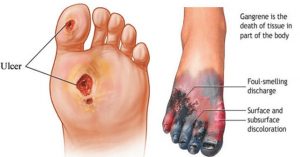By Leandro Perez, MD, FACC, FSCAI, RPVI
 Peripheral artery disease (PAD) is an epidemic that causes blood flow to diminish and puts patients at high risk for heart attacks and other cardiovascular events due to narrowing of the arteries, atherosclerosis (buildup of plaque), and the risk of plaque sloughing off and creating clots. The advanced stages of PAD, which occludes blood flow, especially in the tibia and foot arteries, causing ulcerations, gangrene, and tissue loss, is known as Chronic Limb Ischemia (CLI). CLI is an occlusive disease state that doesn’t provide adequate perfusion to complete the metabolic demands of the body. The Global Burden of Disease study reported that 202 million adults worldwide have PAD and with that staggering number, CLI is increasing escalating. Few other diseases have as high of a mortality rate as CLI.
Peripheral artery disease (PAD) is an epidemic that causes blood flow to diminish and puts patients at high risk for heart attacks and other cardiovascular events due to narrowing of the arteries, atherosclerosis (buildup of plaque), and the risk of plaque sloughing off and creating clots. The advanced stages of PAD, which occludes blood flow, especially in the tibia and foot arteries, causing ulcerations, gangrene, and tissue loss, is known as Chronic Limb Ischemia (CLI). CLI is an occlusive disease state that doesn’t provide adequate perfusion to complete the metabolic demands of the body. The Global Burden of Disease study reported that 202 million adults worldwide have PAD and with that staggering number, CLI is increasing escalating. Few other diseases have as high of a mortality rate as CLI.
Approximately 2 million people in the U.S. have CLI, but that number is probably much higher as it often goes undiagnosed until the disease is severely advanced.
Many physicians resort to amputation to try and save their patient’s lives, but it’s unfortunately often performed unnecessarily, and it puts patients at a higher risk of death. Amputation severely reduces a person’s survival rate. Because CLI is increasing in record numbers, patients’ survival rates are much worse than that of many deadly cancers, yet there is no clear strategic protocol in place by the government to help patients survive and better prepare and mandate their physician’s treatment plans.
In south Florida, we are seeing record numbers of people that were recommended amputation. In most of these cases, it is unfounded.
Patients with CLI almost always have comorbidities such as diabetes, hypertension, high cholesterol, kidney disease, and extensive atherosclerosis throughout their bodies. Angiography is a critical tool to understand the patient’s vascular health overall. Sadly, many patients with CLI are never offered any in-depth imaging studies. With the proper testing, physicians can decide how to best treat the patient and avoid amputation through revascularization procedures. Patients who undergo amputation have double the risk within the year of death.
Making sure we educate the public on their options with PAD and CLI is critical.
The most common symptoms with PAD are pain with exertion, most of the time, the pain is in the calf, but it can be anywhere in the extremity and sometimes in the buttocks. Pain can present as cramps or sharp and usually relieved by resting—most people complain of cold or numb feet or loss of hair, and some experience weak legs.
Diagnosis is confirmed by performing a detailed physical examination of the legs, checking for pulses, and corroborated using ultrasound and Doppler; with arterial disease; we also add an Ankle-Brachial Index or ABI, which measures the blood flow in your extremities. These tests are simple to perform and done in an office setting.
Once diagnosis is confirmed, then there are multiple treatment options and can be conservative or invasive; it all depends on the severity of the condition.
For more advanced conditions, invasive treatment is needed. Until recently, invasive treatments were mostly surgical, very traumatic with days of recovery in hospital post-surgery; however, in the last decade, the introduction of percutaneous non-surgical techniques procedures has shifted the treatments from surgery to catheter-based interventions that do not require blades or general anesthesia. The same techniques used to open arteries of the heart without surgeries using catheter-based therapy are now the method of choice for the treatment of venous or arterial disease of the legs.
The introduction of catheter-based techniques has now caused a shift from a surgical technique to a percutaneous technique that can be done in the comfort of an office without the need of hospitalization, all done under local anesthesia as an outpatient procedure.
You have options. Being educated on vascular conditions and the available treatment is to your advantage. We hope to spread the word on CLI and help patients avoid unnecessary amputation.
At the Naples Cardiac & Endovascular Center we deliver comprehensive heart and vascular care tailored to you.
Leandro Perez, MD, FACC, FSCAI, RPVI
Dr. Leandro Perez is a board-certified cardiac and endovascular specialist with extensive expertise in arterial disease and also an expert in the “wrist procedure” for heart catheterization and limb angiograms. His primary focus is limb amputation prevention and limb ischemia and leads NCEC in these efforts educating the community and health care providers in Southwest Florida on these conditions. He uses a non-surgical treatment of arterial disease to preserve the arteries of the leg, similar to the techniques he uses to treat the arteries of the heart. He is dedicated to combatting the epidemic of limb amputation using his skills and experience in helping these patients at risk for losing a toe, feet, or limbs due to poor circulation.
For more information call 239-300-0586 or visit www.heartvein.com.
Naples Cardiac & Endovascular Center
(239) 300-0586 | www.heartvein.com
1168 Goodlette-Frank Rd N Naples, FL 34102
9400 Bonita Beach rd. S.E. Suite 203.
Bonita Springs FL 34135








